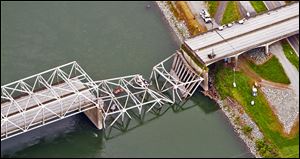
Ohio’s aging bridges raise safety concerns
Collapse in Washington raises concerns about Ohio bridge safety
5/28/2013
A section of the I-5 bridge over the Skagit River in Washington state collapsed on Thursday after a truck hit a girder. Across Ohio, 5,761 county-maintained bridges are considered functionally obsolete or deficient.
COLUMBUS — Ohio has 278 bridges similar to the one that collapsed in Washington state last week, sending cars and people into the water below.
Although Ohio transportation officials point out that Washington’s bridge collapse was caused by a truck that hit a girder — not a failing bridge — the accident renews concerns about bridge safety as infrastructure ages throughout the country and Ohio.
“What happened in Washington could happen anywhere, and it’s going to happen over and over again,” Mark Policinski, executive director of the Ohio-Kentucky-Indiana Regional Council of Governments — the region’s top transportation planning agency — told The Cincinnati Enquirer.
“You don’t have to be a doom and gloomer to see that,” Mr. Policinski said. “You just have to be a realist. These structures are way behind their lifespan. You have to have the political will to say this has to be a national priority, and what we have to develop first is the will to do what’s right to protect people’s lives.”
Of Ohio’s 44,000 bridges, 278 are similar to the one that collapsed in Washington, according to the County Engineers Association of Ohio.
They are known as through-truss bridges. Damage to one key piece could bring down an entire span.
In Washington on Thursday, a truck that was too tall for the span hit a girder, causing the bridge to collapse.
Two cars fell into the Skagit River below. Nobody was killed.
The bridge had been deemed “functionally obsolete,” or not meeting current design standards.
Across Ohio, 5,761 of about 26,900 county-maintained bridges are considered functionally obsolete or structurally deficient, Fred Pausch, executive director of the state county engineers association, told The Columbus Dispatch.
Today, bridges are built with a 50-year life expectancy, Mr. Pausch said.
Many are older. Five in central Ohio are more than 100 years old.
In the Cincinnati area and in northern Kentucky — just across the Ohio River — the Enquirer reports that nearly 100 bridges are either so old or have such significant defects that they require weight limits.
Like the Washington bridge that collapsed, the 50-year-old Brent Spence Bridge — which spans the Ohio River between Cincinnati and northern Kentucky and is the region’s most heavily traveled bridge — has been listed as functionally obsolete. The bridge has narrow lanes, no emergency shoulders, and limited visibility on the lower deck.
Ohio Gov. John Kasich, Kentucky Gov. Steve Beshear, and the Cincinnati business community have been pushing for a new bridge to be built.
A finance plan is not in place. Federal earmarks have been banned, and Northern Kentucky state lawmakers have resisted passing legislation they fear would lead to tolling the Kentucky-owned bridge.
In Cleveland, the rusting Inner Belt Bridge over the Cuyahoga River is in “serious condition,” inspectors reported, and the Ohio Department of Transportation — which has spent $10 million to bolster weak sections — advises trucks not to use it, according to the Plain Dealer.
The bridge will be closed to traffic later this year for good and demolished, once the first of two new bridges is finished.
Also in Cleveland last year, the department banned trucks from using the Main Avenue Bridge for five months after an inspection revealed weakness in several steel plates. The department did $500,000 in emergency repairs on the bridge, which inspectors rate in “poor” condition.
Steve Faulkner, an Ohio Department of Transportation spokesman, emphasized that human error led to the bridge collapse in Washington.
“Even the safest bridge in Ohio isn’t safe from a motorist who doesn’t follow laws and restrictions,” Mr. Faulkner said.
Although the Federal Highway Administration requires that bridges be inspected every two years, Ohio inspects its bridges every year, he said.
For bridges that collapse like the one in Washington, though, it comes down to simple physics.
“One overweight [or too-tall] truck that hits a bridge in the wrong spot, and you see what can happens,” Mr. Pausch said.